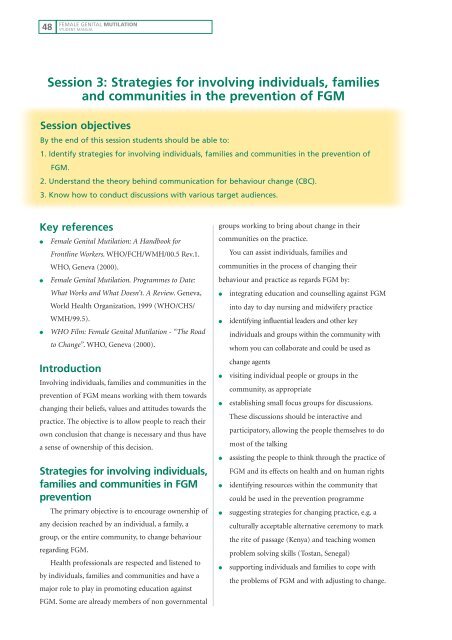Female Genital Mutilation - World Health Organization
Female Genital Mutilation - World Health Organization
Female Genital Mutilation - World Health Organization
You also want an ePaper? Increase the reach of your titles
YUMPU automatically turns print PDFs into web optimized ePapers that Google loves.
48<br />
FEMALE GENITAL MUTILATION<br />
STUDENT MANUAL<br />
Session 3: Strategies for involving individuals, families<br />
and communities in the prevention of FGM<br />
Session objectives<br />
By the end of this session students should be able to:<br />
1. Identify strategies for involving individuals, families and communities in the prevention of<br />
FGM.<br />
2. Understand the theory behind communication for behaviour change (CBC).<br />
3. Know how to conduct discussions with various target audiences.<br />
Key references<br />
● <strong>Female</strong> <strong>Genital</strong> <strong>Mutilation</strong>: A Handbook for<br />
Frontline Workers. WHO/FCH/WMH/00.5 Rev.1.<br />
WHO, Geneva (2000).<br />
● <strong>Female</strong> <strong>Genital</strong> <strong>Mutilation</strong>. Programmes to Date:<br />
What Works and What Doesn’t. A Review.Geneva,<br />
<strong>World</strong> <strong>Health</strong> <strong>Organization</strong>, 1999 (WHO/CHS/<br />
WMH/99.5).<br />
● WHO Film: <strong>Female</strong> <strong>Genital</strong> <strong>Mutilation</strong> - “The Road<br />
to Change”. WHO, Geneva (2000).<br />
Introduction<br />
Involving individuals, families and communities in the<br />
prevention of FGM means working with them towards<br />
changing their beliefs, values and attitudes towards the<br />
practice. The objective is to allow people to reach their<br />
own conclusion that change is necessary and thus have<br />
a sense of ownership of this decision.<br />
Strategies for involving individuals,<br />
families and communities in FGM<br />
prevention<br />
The primary objective is to encourage ownership of<br />
any decision reached by an individual, a family, a<br />
group, or the entire community, to change behaviour<br />
regarding FGM.<br />
<strong>Health</strong> professionals are respected and listened to<br />
by individuals, families and communities and have a<br />
major role to play in promoting education against<br />
FGM. Some are already members of non governmental<br />
groups working to bring about change in their<br />
communities on the practice.<br />
You can assist individuals, families and<br />
communities in the process of changing their<br />
behaviour and practice as regards FGM by:<br />
● integrating education and counselling against FGM<br />
into day to day nursing and midwifery practice<br />
● identifying influential leaders and other key<br />
individuals and groups within the community with<br />
whom you can collaborate and could be used as<br />
change agents<br />
● visiting individual people or groups in the<br />
community, as appropriate<br />
● establishing small focus groups for discussions.<br />
These discussions should be interactive and<br />
participatory, allowing the people themselves to do<br />
most of the talking<br />
● assisting the people to think through the practice of<br />
FGM and its effects on health and on human rights<br />
● identifying resources within the community that<br />
could be used in the prevention programme<br />
● suggesting strategies for changing practice, e.g. a<br />
culturally acceptable alternative ceremony to mark<br />
the rite of passage (Kenya) and teaching women<br />
problem solving skills (Tostan, Senegal)<br />
● supporting individuals and families to cope with<br />
the problems of FGM and with adjusting to change.

















